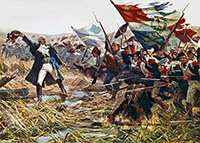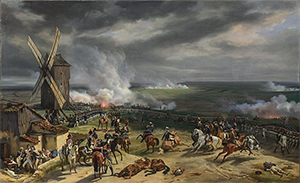The War of the First Coalition
Part 2: Advances and Setbacks
As well, the French Army faced enemies from within. Queen Marie Antoinette was from Austria. She sought to prevent a complete elimination of the monarchy by embracing the efforts of Austria and others in restoring her husband to her former power; to do so, she obtained her army's war plans and passed them to the Austrian war department. 
One bright spot for French troops was their new battle hymn, Chant de guerre pour l'armée de Rhin ("War Song for the Rhine Army"), which Rouget de Lisle had recently. composed. Soldiers across the country sang it, but it became known as the song of a battalion from Marseille and so became La Marseilliaise (by which it is still known today). The war was not kind to France from the outset. One group of French soldiers fled the battlefield and fell on their own general instead, accusing him of treason and executing him on the spot. Other French forces went into battle but found defeat. Rochambeau resigned, and Lafayette did not survive a subsequent reorganization. A second French invasion, in June, had some success, capturing two towns. The result, however, was the growth of the force allied against them. The Duke of Brunswick issued the Brunswick Manifesto, which proclaimed that any harm inflicted on the French royal family would result in devastation of Paris. He then marched at the head of an allied force of Austrians, French émigrés, Hessians, and Prussians, into the heart of France, besieging Verdun and then marching on Paris. What looked like certain French defeat turned into something entirely different at Valmy, on Sept. 20, 1792. French artillery ruled the day, and the allied force retreated. The beleaguered allied force, far from home, retreated further, battling against dysentery and broken supply lines as well as an inspired force of French pursuers. French troops seized the Prussian city of Mainz in short order and, at the end of October, Frankfurt as well. 
Meanwhile, the landscape inside France had changed rapidly. In August, as French troops were regrouping, a crowd of radicals stormed the Tuileries Palace and seized the royal family, placing them in lockdown in the Square du Temple. The next month, on the same day that French guns had won a resounding victory at Valmy, the Legislative Assembly had transferred its lawmaking authority to the National Convention. Within two days, the Convention had abolished the monarchy and declared the French Republic. French armies had scored a few other successes during the last few months of 1792, including the occupation of Italian centers Nice and Savoy and German cities Mainz, Speyer, and Worms. Perhaps the most significant victory came in what is now Belgium. The French victory at Valmy in late September had proved to the rest of Europe that French troops were the equal if not the better of their opponents. The commander Chalres Dumouriez followed up the victory at Valmy with a drive north, in an invasion of the Austrian Netherlands. The two forces met at Jemappes. 
The French army numbered 40,000 by this time (including the commander of the center, General Egalite, the future King Louis-Philippe). The Austrian commander, the Austrian Netherlands commander Duke Albert of Saxe-Teschen, had only half that many troops anyway and had to deploy them in a long line of defense and so at Jemappes had less than 12,000 at his disposal. Evening the scales somewhat was the fact that the Austrian forces were experienced, up and down the chain of command, whereas the French had suffered a large number of defections of experienced officers in the wake of the political upheaval back home and also had added a large number of raw recruits to the general order. The Austrians settled into an entrenchment and trained their big guns on the path that the French army was sure to take. The battle took place on November 6. The Austrians did indeed have 56 big guns, which they deployed to good effect. However, the French had more than 100 big guns, and they employed them to devastating effect. As well, the French infantry proved up to the task, overwhelming the defense force after a series of attacks and winning the day. Casualties were high on both sides, but the victory had given France control of the Austrian Netherlands. Wasting no time, Dumouriez moved his men onward, taking Brussels on November 14 and completing the occupation of Belgium. Next page > A Grand Coalition > Page 1, 2, 3, 4 |
|
Social Studies for Kids
copyright 2002–2025
David White



 One significant change to military procedures as a result of the drive toward more equality–that officers be appointed according to ability rather than nobility–convinced many existing officers to join those leaving the country. Thus, when France declared war on Austria on April 20, 1792, it did so with a relatively new raft of officers. The same was true for the equivalent of the enlisted men. Many of the 164,000 soldiers who went to war with Austria were poorly trained and poorly equipped. They had talented, experienced commanders in the
One significant change to military procedures as a result of the drive toward more equality–that officers be appointed according to ability rather than nobility–convinced many existing officers to join those leaving the country. Thus, when France declared war on Austria on April 20, 1792, it did so with a relatively new raft of officers. The same was true for the equivalent of the enlisted men. Many of the 164,000 soldiers who went to war with Austria were poorly trained and poorly equipped. They had talented, experienced commanders in the 
